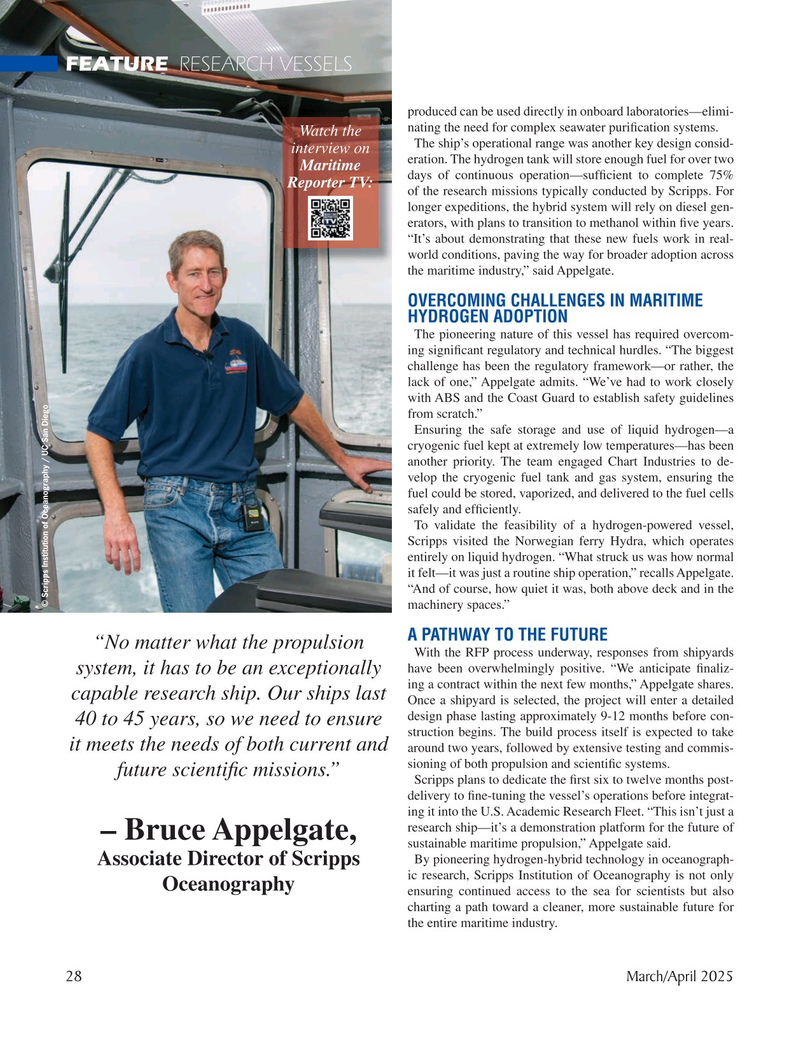
Page 28: of Marine Technology Magazine (March 2025)
Read this page in Pdf, Flash or Html5 edition of March 2025 Marine Technology Magazine
FEATURE RESEARCH VESSELS produced can be used directly in onboard laboratories—elimi- nating the need for complex seawater puri? cation systems.
Watch the
The ship’s operational range was another key design consid- interview on eration. The hydrogen tank will store enough fuel for over two
Maritime days of continuous operation—suf? cient to complete 75%
Reporter TV: of the research missions typically conducted by Scripps. For longer expeditions, the hybrid system will rely on diesel gen- erators, with plans to transition to methanol within ? ve years. “It’s about demonstrating that these new fuels work in real- world conditions, paving the way for broader adoption across the maritime industry,” said Appelgate.
OVERCOMING CHALLENGES IN MARITIME
HYDROGEN ADOPTION
The pioneering nature of this vessel has required overcom- ing signi? cant regulatory and technical hurdles. “The biggest challenge has been the regulatory framework—or rather, the lack of one,” Appelgate admits. “We’ve had to work closely with ABS and the Coast Guard to establish safety guidelines from scratch.”
Ensuring the safe storage and use of liquid hydrogen—a cryogenic fuel kept at extremely low temperatures—has been another priority. The team engaged Chart Industries to de- velop the cryogenic fuel tank and gas system, ensuring the fuel could be stored, vaporized, and delivered to the fuel cells safely and ef? ciently.
To validate the feasibility of a hydrogen-powered vessel,
Scripps visited the Norwegian ferry Hydra, which operates entirely on liquid hydrogen. “What struck us was how normal it felt—it was just a routine ship operation,” recalls Appelgate. “And of course, how quiet it was, both above deck and in the © Scripps Institution of Oceanography / UC San Diego machinery spaces.”
A PATHWAY TO THE FUTURE “No matter what the propulsion
With the RFP process underway, responses from shipyards have been overwhelmingly positive. “We anticipate ? naliz- system, it has to be an exceptionally ing a contract within the next few months,” Appelgate shares. capable research ship. Our ships last
Once a shipyard is selected, the project will enter a detailed design phase lasting approximately 9-12 months before con- 40 to 45 years, so we need to ensure struction begins. The build process itself is expected to take it meets the needs of both current and around two years, followed by extensive testing and commis- sioning of both propulsion and scienti? c systems.
future scienti? c missions.”
Scripps plans to dedicate the ? rst six to twelve months post- delivery to ? ne-tuning the vessel’s operations before integrat- ing it into the U.S. Academic Research Fleet. “This isn’t just a research ship—it’s a demonstration platform for the future of – Bruce Appelgate, sustainable maritime propulsion,” Appelgate said.
By pioneering hydrogen-hybrid technology in oceanograph-
Associate Director of Scripps ic research, Scripps Institution of Oceanography is not only
Oceanography ensuring continued access to the sea for scientists but also charting a path toward a cleaner, more sustainable future for the entire maritime industry.
28 March/April 2025
MTR #3 (18-33).indd 28 3/13/2025 5:22:32 PM

 27
27

 29
29
